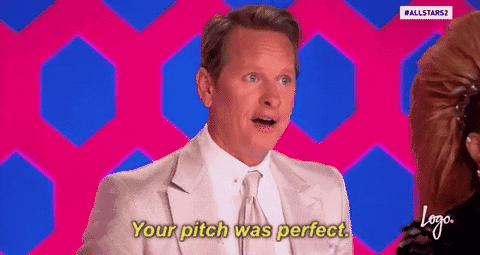⭐️ The formula for the perfect pitch
How do I present ideas successfully? A guide in 3.5 steps.
Hello 👋 My name is Florian Schleicher and this is the FutureStrategies newsletter from FutureS. I'm glad you're reading along 💚 If you want to learn strategic marketing, my Simple & Sustainable Marketing Academy is just right for you.
For those who want to present their own ideas, pitches have become a familiar and often dreaded term.
So that we have the same understanding:
For me, a pitch is a short presentation (in words, videos, pictures, etc.) that has the goal of bringing about a change in behavior.
So from a project proposal within a company to a funding round for startups to my idea for an event among friends.
The process and intention are always the same.
By the way, the Cambridge Dictionary defines a pitch as
“A speech or act that attempts to persuade someone to buy or do something.”
There are also many references in pop culture. From the TV series Mad Men to about every show around startups. Pitches are everywhere.
A perfect pitch is more than just a good set of slides.
From my perspective, there are three key points that make our pitch successful.
Define the problem
Outline a desirable future
Describe your solution
(For fans of communications expert Barack Obama - he's rehashed almost every speech he's given just like this).
These 3 points can be communicated in any order. However, I like to start in exactly the above or swap out 1 and 2.
Today we will devote ourselves to these 3 points.
But before that, one point, the "0.5" from the headline is still important:
🕵️ Know your target group
As with any strategic communication, our journey always begins with the target audience.
Why?
It makes a huge difference whether I'm pitching to my grandparents, a fan club, or future investors.
They all have different needs, problems, and perspectives that I need to address and take into account.
So every good pitch starts with a deep understanding of the target group. It is particularly advantageous if we build on an insight.
An Insight is an emotional expression of an unmet need or desire that is not obvious, but touches and triggers an "Oh, I see!" moment.
Don't get me wrong: this is the most important and at the same time the most difficult part of the pitch. Because here we have to get into the heads and hearts of other people.
Once we have identified this Insight, then we can get to work on developing our pitch:
🙄 Define the problem
Why does it actually take a new solution, a new startup, or a new event?
Before we can pitch our idea, we have to make it clear that there is a problem and illuminate it from an interesting angle.
“The diagnosis defines or explains the nature of the challenge. A good diagnosis simplifies the often overwhelming complexity of reality by identifying certain aspects of the situation as critical. A diagnosis names or classifies the situation, linking facts into patterns, and suggesting that more attention be paid to some issues and less to others.”
Richard Rumelt, Good Strategy, Bad Strategy
A good problem really hurts our target group.
This is how I learned to prepare a good pitch from my own mentors.
So here we want to deliberately describe a situation that triggers fears, big problems, and obstacles. If we can load our problem with data, statistics, facts, interviews, and statements, this can be very helpful for certain target groups (for my grandparents, however, not so much, there I would work with more emotions).
The target audience should think to themselves, "This is a huge issue that is weighing on me (and many others). And there's no way out right now. What am I going to do?"
This point in the perfect pitch helps us to attract full attention.
Because problems make you sit up and take notice in a world that has a constant battle for limited attention.
🔮 Outline the desirable future
Once we've made it clear what the problem is and thus why it's important that we're listened to, it's time to turn it around into the opposite.
So the second step in our perfect pitch is to outline a future that our target audience will find interesting enough to continue following us.
In doing so, it is best to pay attention to a very precise description of the future we want to build. The more details, the better. We want to create a real desire for this beautiful picture in which our problem no longer exists.
“To help you imagine a future more clearly, skip ahead to ten years from today. Now, fill in the blank space. What do you have planned, ten years from today? Who are you doing it with? What will you be wearing? What supplies will you need? Why is this activity important or exciting for you? And how do you feel now that the day is here?”
Jane McGonigal, Imaginable
At this point in the perfect pitch, we want our target audience to think to themselves, "Wow, that would be really nice to have. I want that."
So we work with curiosity and a strong incentive.
We now have our target group at exactly the right point:
They have recognized their dilemma in the problem. They dream of a more beautiful world.
Now only one thing is missing: the way to get there.
💡 Describe your solution
Our solution now falls on fertile ground. It represents the path from the problem to the desirable future.
This rounds out the perfect pitch.
We lift the curtain and talk about our idea with confidence.
When describing the solution, it is again important to pay attention to the target group. So: Do we need more data? Or images? Do we need budgets? Or a concrete package of measures with a timetable?
✍️ Write your own story
The perfect pitch is structured like a story. There are several approaches to this, such as the simple 4-step model:
the beginning
the hero
the villain
the solution
I have described more about this here.
⭐️ The perfect pitch
Developing and presenting the perfect pitch takes one thing above all else:
A lot of practice.
There are thousands of videos and guides for tips and tricks around pitches.
My formula of 3.5 steps is a good starting point.
I would like to share one more exciting trick for all of you who have made it this far:
We can borrow here from the master of pitches Steve Jobs:
Jobs usually started his appearances and presentations with a short teaser. Even before the problem, the future, and the solution, he introduced his pitch with a few simple words that make a promise for everything he will say afterward:
“Here comes a revolutionary product that changes everything.”
So Jobs is working with a "hook", a fishhook he's throwing out, and right away everyone is wondering "What does he mean? Is this really going to change everything?".
And with that, he gets the attention for his next words.
I hope to have given you a good first guideline for your upcoming projects, pitches, and presentations.
So that you and your target group can soon say:
Thank you for reading along.
PS: You can also read this posting in German.
📚 More reading material wanted?
🏁 5 steps for successful start-up marketing - What makes a start-up successful? A guide with practical examples.
👩🎤 Influencer-Marketing - What role do influencers play in the marketing mix and how do successful collaborations come about?
✅ Green marketing with strategy - What does it take for strategic green marketing and which companies are doing a good job?












